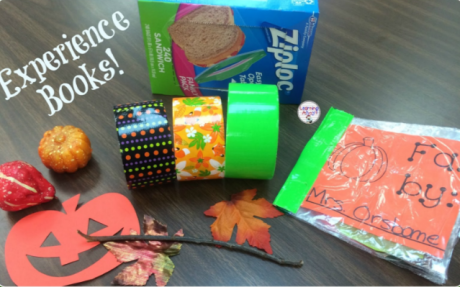Experience stories are a fun and easy way to practice language. They can be created and enjoyed both at home and school and are helpful for any child with language goals.
WHAT IS AN EXPERIENCE STORY?
An experience story begins as an activity that an adult shares with a child. After the activity, a story is created, targeting language that the child needs to practice. The result is a homemade book that includes photos taken during the activity and the child is the main character. It is read together often, providing repeated practice with the target language.

STEP ONE: PRE-PLAN
Of course, you should start by deciding what your activity will be and what language you will target.
You might have an activity in mind (baking cupcakes for the cat’s birthday, washing dishes, a craft project – almost anything will do.) If not, there are plenty of places to find activities online.
To plan the language you will target, imagine you and your child actually doing each step of the activity. What language can you practice when you look at the photos and discuss it afterward?
Plan the sentences you can use in your book. That way, you’ll know when to take pictures during the activity. How many sentences you plan (or actually use) will depend on your child’s language level and ability to sit with a book.
Here are some examples for A Chocolate Milk Experience.
- noun-verb-noun (Mommy opened the milk. Susie poured the milk. Mommy squeezed the chocolate. Susie stirred the milk. Mommy and Susie drank the chocolate milk.
 Yum!)
Yum!)
- noun-preposition-noun (We put the glasses on the table. We put the milk on the table. Mommy poured the milk in the glass. Susie squeezed the chocolate in the glass. Mommy and Susie stirred the milk in the glass. The milk is in our
 tummies. Yum!)
tummies. Yum!)
STEP TWO:
PARTNER PLAN, USING FUTURE TENSE
As mentioned, Experience Books can practice all verb tenses. When the adult and child plan the activity together, they use the future tense to discuss what they will do.
If your language target includes a verb, this is where your child will practice using future tense. If there is no verb target, you can use this step to expose her to future tense — she will hear it, but isn’t expected to understand or repeat it.
You’ll need something physical on hand to talk about. This can be a finished example of what you’re making, a photo of what you’ll make, the written instructions (with illustrations) for your activity or all the items you’ll use in your activity.
Your goal is to have your child produce all of your target sentences in future tense. Here are some examples for our Chocolate Milk Experience. The language targets are underlined. These are the words we want the child to say at the very least.
- noun-verb-noun (Mommy will open the milk. Susie (I) will pour the milk. Mommy will squeeze the chocolate. Susie (I) will stir the milk. We will drink the chocolate milk. Yum!)
- preposition-noun ( Susie (I) will put the milk on the table.Mommy will pour the milk in the glass. Mommy will squeeze the chocolate in the glass. Susie (I) will stir the milk in the glass. We will drink the milk. Chocolate milk will be in our tummies. Yum!)

STEP THREE:
EXPERIENCE THE EXPERIENCE
There are two important things you need to accomplish during the experience.
- Have FUN!
- Take pictures
FUN: The fun will keep the child motivated for future experiences. We certainly don’t want a language experience to become a time when the child feels the pressure of saying everything exactly the way you want it said.
While one of the benefits of Experience Stories is practicing all verb tenses around one experience, I suggest that present tense not be practiced during the first experience. During the first couple experiences, the child will be learning how the process works. She’ll be listening, following directions, using tools and so much more. Delaying the fun of pouring stuff into a bowl until the language is produced might be too much. But when some of those participation skills have been developed, the child should be expected to imitate the language that you planned in Step One.
For every experience, from the very beginning, the adult should be narrating the activity, using the present tense and highlighting any new vocabulary. The child should repeat the adult’s language, including as many words as possible, in the correct order, with her best possible speech. You can try to correct or improve her language, but if three attempts don’t achieve that goal, then model the correct language once more and go back to having fun.
Here’s the present tense noun-verb-noun language for the Chocolate Milk Experience. (Great name for a band!)
Mommy is opening the milk. I am pouring the milk. Mommy is squeezing the chocolate. I am stirring the milk. We are drinking the chocolate milk.
Yum!)
While this can be an opportunity to practice present tense, the most beneficial language practice comes with the book. The experience itself is the memory upon which the language is built.
TAKING PICTURES: During the experience, pause for a few candid and a few posed pictures. Your child can see the picture and use the present tense sentence again. The pictures are for your Experience Book. It’s what makes the book personal and supports comprehension of the language. But fear not. If you were so caught up in the fun of the experience that you forget to snap a shot for each of your target sentences, you can always ‘stage’ the shots in a re-enactment. Or make your drawings to evoke the memories.
Remember: the experience must always be  .
.

STEP FOUR: CREATE THE EXPERIENCE BOOK
The materials you use to create the book are up to you. You can tape the pictures into an everyday notebook that holds several experience stories. You can print it out on the computer and staple it. (Tape over the backs of the staples to prevent scratches.) Use a photo album or brag book. Use Ziploc bags and duct tape. A hole punch, index cards and ring.
I like to have the child’s handwriting on each page. A good way to start is to have her write her name and names of family members every time they appear. Provide the traditional primary lines to encourage good penmanship.
Books based on true experiences should be written in past tense – because the experience happened in the past. This reinforces the meaning and usage of past tense, which can be challenging for kids who are deaf.
Here’s the final noun-verb-noun version of the Chocolate Milk Experience.
Mommy opened the milk. Susie poured the milk. Mommy squeezed the chocolate. Susie stirred the milk. Susie and Mommy drank the chocolate milk.
Yum!)

A topical non-fiction book, while not really an “experience story,” can still repeat the same language. This one repeats the pattern “Do (chipmunks) have spots? No! (chipmunks) have stripes!” to practice present tense for plural verbs and “Do” questions.
STEP FIVE: USING THE BOOK TO PRACTICE LANGUAGE
The Prime Directive:
Experiences & Experience Books Must Always be FUN.
This promotes the enjoyment
of more experience stories,
love for language and love for books.
- First readings should be about becoming familiar with the book, appreciating the pictures and remembering the experience.
- When the book itself is familiar, the purpose becomes to practice language. Repetitive reading of the book will promote language learning.
- When the language is more familiar to the child, use post-it notes to cover the target language (for example, the preposition) to require the child to think about what word belongs there.
- Ask questions that require the child to use the target language in her answer. For example, “Who poured the milk?” to have her answer, “Mommy poured the milk.” “What did you squeeze?” “I squeezed the chocolate.”
- When pronouns are a language target, change the names in the book to pronouns when reading it. For example the child and the child’s activity partner say “I” and “you” to replace their own names. For others’ names, they use “he” and “she.”
- For beginning readers, have the child point to certain words.
- To practice listening and auditory comprehension, the adult says a sentence from the book and child finds the picture for that sentence. Have her repeat the sentence back to you for extra language practice.
SHARE THE BOOK
Some suggestions:
- Share the book with extended family, babysitters and teachers. They help promote carryover of the language into their time with your child.
- It can be fun to put an extra page at the end and have others write comments about the story.
- Keep your Experience Books as a collection and a memory of fun activities and language growth. When language or vocabulary from a previous activity needs to be reviewed, you can read that book again. Or read it again just for fun!
I’d love to hear about your favorite experience stories
and other ways you use Experience Books.








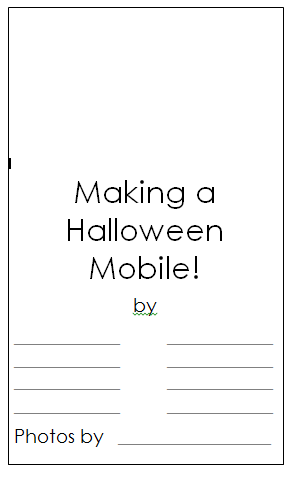



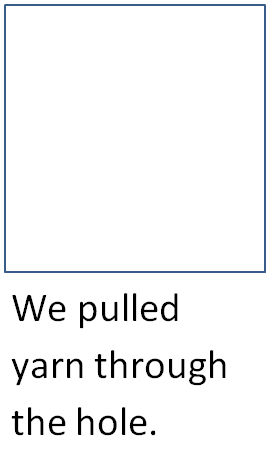

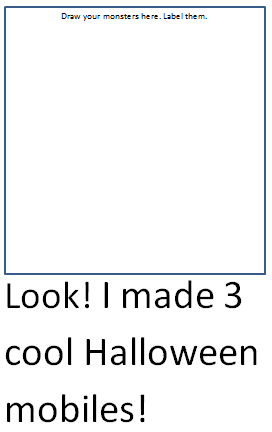





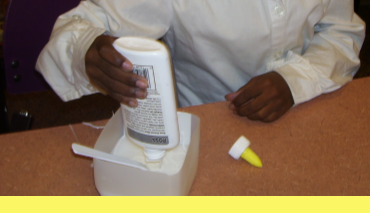
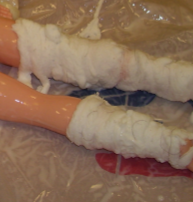


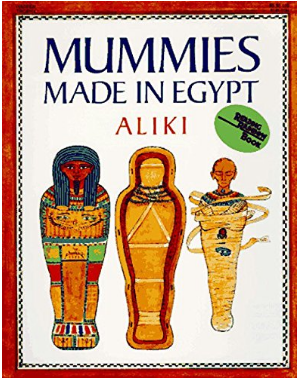


 Yum!)
Yum!) tummies
tummies
 .
.



